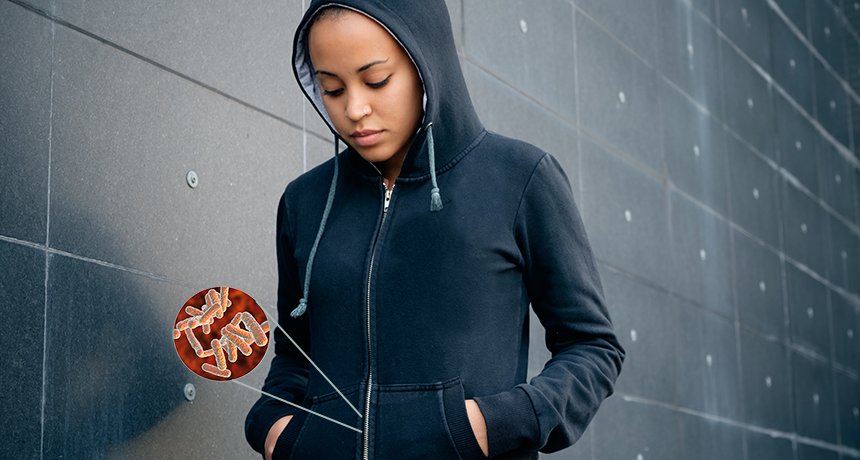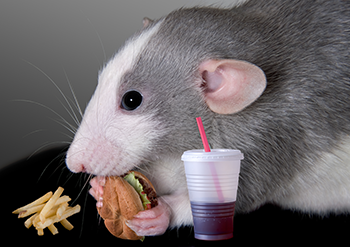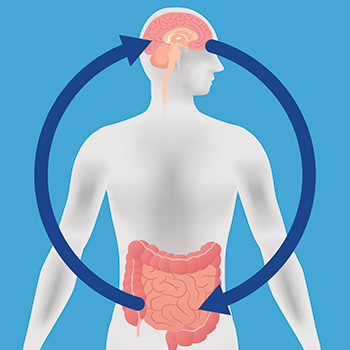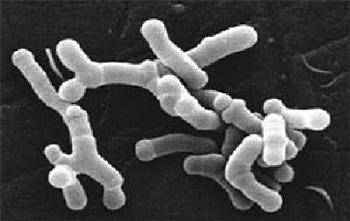Belly bacteria can shape mood and behavior
Conversations between the brain and gut may influence stress, memory and more

You may not notice, but your guts and brain are in constant communication. And from what scientists have been learning from rodent studies, those chats between gut microbes and the brain can have a whole range of important, hidden impacts.
tommaso79, Dr_Microbe/iStockphoto; Adapted by L. Steenblik Hwang
When Margaret Morris goes to the grocery store, people ask if she’s throwing a party. Her cart is filled with French fries, cheesecakes, meat pies and other tasty treats. “I snoop around looking for specials,” she says. “I spend a lot of money on food.”
Morris is a neuroscientist — someone who studies the brain. She works at the University of New South Wales in Sydney, Australia. And yes, she is throwing a party. But her guests aren’t people. This fast-food feast is destined for her lab rats. After a few weeks of all the junk food they can eat, Morris and her colleagues run the rodents through a series of tasks, testing the limits of their learning and memory.

By letting rats chow down on these foods, Morris is trying to find out how a junk-food diet (popular among people, too) impacts behaviors. She studies what’s called the gut-brain axis. It refers to the ongoing conversation taking place between the brain and gut. Because of this chatter, our innards — and the microbes living in them — can affect how we think and behave. Our brain, in turn, can talk back to our stomach and intestines and their bacterial inhabitants.
By studying how residents of our gut influence our brain, Morris and other scientists seek to find out just how much you are what you eat. Their results may one day enable us to change our feelings and behaviors — all with the right mix of foods and microbes.
From gut to brain
It’s no surprise that our brain sends signals to our gut to control digestion and other tasks. The brain sends its orders via the vagus (VAY-gus) nerve. This long structure wanders from the very base of the brain down to the gut. Along the way, it touches many other organs. The brain makes hormones — chemical signals that it drips into the bloodstream. These, too, flow to the gut. Both the vagus nerve and hormones can signal hunger and fullness. They can control, too, how quickly food moves through us.
But the gut doesn’t just listen. It also talks back.

Microbes inside our stomach and intestines help break down food. Those microbes poop out waste products that can themselves serve as chemical messengers. These waste molecules can trigger a cascade of signals throughout the rest of the body.
Some microbial cross-talk prompts stomach-lining cells to send chemical text-messages to the immune system. This can protect us from infection. Some microbes shoot molecular signals back up the vagus nerve. Others pump messages — hormones — into the bloodstream, from which they’ll travel to the brain. Those hormones can affect everything from memory skills to mood.
Scientists didn’t always know about the gut’s back chatter to the brain. Its role began to emerge when they started digging into the microbes in, well, poop.
“When I was a student in the 1960s and 1970s, I thought everything was known,” says Mark Lyte. He’s a microbial endocrinologist — someone who studies microbes and the hormones they release — at Iowa State University in Ames. “Who considered that the poop you took in the morning was going to be such a hot topic? Poop was poop!”
Lyte was interested in microbes in the gut that might cause infection. But he soon realized that some gut bacteria were sending messages. Those signals consisted of chemicals that looked very familiar. These germs were producing some of the same molecules used when one brain cell communicates with another — a process known as neurotransmission.
“These are the same things we have in our brains and [that our brain cells] use for communication,” he says. Soon, he wondered: “Could it be that bacteria are communicating with us all the time?”
As scientists learned to listen in on that bacterial chatter, they discovered he was right. The brain and gut send constant cascades of notes back and forth, more than any social media. And that peaceful communication serves a critical purpose, Lyte says. “You have trillions of bugs in your gut and you rely on them for a lot of your nutrients. But they rely on you to sustain themselves,” he says. “They need to communicate with you. And you need to communicate with them.”
Tummy trouble
Exactly what the messages say depends on who’s sending them. A gut filled with fruits and vegetables will house a different set of microbes than one used to a diet of chips, soda and other junk foods. And the messages sent by those different sets of gut microbes may affect our brains differently.
This is where Morris’ rat parties come in.
After two weeks on a junk-food diet replete with cakes and fries, her lab rats take a memory test. Each rodent investigates a space filled with objects. Then, after the rat leaves, Morris and her colleagues move some of the objects around. The next day, they put the rat back into the space. If it notices a change in the furnishings, it will spend more time sniffing around the objects that had moved.
Tests like this one rely on an area of the brain called the hippocampus (there are two in each brain). These regions are very important for learning and memory. But after a few weeks of downing junk food, a rat’s hippocampi no longer work so well. The animals don’t seem to recognize which objects have been moved as well as do rats that noshed on healthy foods.

Could this be because of their gut bugs?
Rats that dine on fast food have a less diverse group of microbes in their guts, Morris and her group find. But their gut diversity returned when the scientists gave the junk-food-eating animals a high dose of a probiotic — a mix of beneficial gut bacteria. Their memory also improved.
Morris and her colleagues published their findings in the March 2017 Molecular Psychiatry.
Gut feelings
What we put in our guts can affect our brains, but our brains also affect our guts. Indeed, Lyte’s group has shown that when mice go through stressed times, their gut microbes feel the pressure.
The scientists put mice into tight little tubes that restrained their movements. And the rodents didn’t like that very much. The stress they felt during this restraint test altered the share of certain bacteria in their gut. The new populations in the stressed-out mice weren’t as diverse as those in the relaxed mice. Guts in the stressed animals also were more susceptible to bacteria that could make the mice sick, the researchers found.
Social stress — such as being bullied — also can change bacteria living in animals’ guts, notes Jiah Pearson-Leary. He’s a neuroscientist in Pennsylvania at Children’s Hospital of Philadelphia. There, he bullies rats to see how it affects their guts.
Rats are social. They like to be around other rats. But they are not big fans of new roommates. So when a big rat “owns” its own cage, it doesn’t want some small newcomer rat moving in. If a smaller rat is foolish enough to approach him, the bigger rat will beat him up. When the same rat experiences this bullying over and over, it can become very stressed. It’s known as social defeat stress. Some beaten rats may even show signs of depression. They might avoid socializing with others. They may even lose interest in sweet rat treats.

Not all rats respond the same way, however. Some handle the stress better than others. They can take longer before breaking under the strain. Pearson-Leary has now shown that those who suffer the most also tend to have very different gut bugs than do the rats who can better stand the pressure.
Pearson-Leary took poop from rats that got stressed quickly and fed it to unstressed rats. (Rats often eat each other’s feces, he notes, so this isn’t too weird. “They enjoy it, I think.”) Poop will always contain some of an animal’s gut microbes. So the unstressed rats also got a taste of the stressed rats’ gut microbes. “We just wanted to see how much of the behavior [might also] be transferred,” he explains.
After eating a poop-shake made of a stressed rat’s feces, formerly chill rats now got stressed much faster when bullied. They showed depressed behavior more quickly, too.
Pearson-Leary shared his team’s findings, last November, at the Society for Neuroscience meeting in Washington, D.C.
An intestinal ecosystem
Clearly, our guts are not just a simple tube into which we send food. They are remarkably complex ecosystems. Their inhabitants are part of what’s known as our microbiome (My-kroh-BY-oam) — a community of microbes that live in and on us. In the gut, the star players are bacteria that feed on the buffet flowing past them. These microbes don’t have an easy life, though. They are constantly fending off attackers.
That’s because our guts are home not just to bacteria, but also to viruses — tiny particles made of genes and coated in proteins. Those viruses hijack the cells they infect. They then turn these cells into factories that pump out more virus.
In the gut, most of this sinister-sounding activity isn’t aimed at us. “Percentage-wise, probably 95 percent of the viruses are bacteriophages,” explains Veronica Peterson. She is a neuroscientist at University College Cork in Ireland. Bacteriophages (Bak-TEER-ee-oh-faaj-uhs) are viruses. They have no interest in us. They have come to infect the microbes hanging out within us.
Think of those viruses as predators hunting their microbial prey in the savanna of your intestines.
Scientists had long known these viruses were present. They even have a name for this community: the virome (VY-roam). But “we knew absolutely nothing,” Peterson recalls, about whether the viruses were affected by our behavior — or might affect us.
She and her colleagues decided to probe the role of those viruses. They now report finding that stress can shake up the bacteria in mousey guts.
And that’s not all. “After stress, there’s an increase [in] viral diversity, a lot of new types of viruses,” Peterson reports.
Greater viral variety meant gut microbes are under more strain. No surprise, the types of bacteria in stressed mice went down. That indicates “that most of the viruses are bacteriophages, killing off bacteria,” Peterson says. Dead bacteria no longer send signals — positive or otherwise — to the brain.
She, too, shared her findings at last November’s meeting of the Society for Neuroscience.
Gut bacteria and viruses have a third set of companions: fungi. “These are single-celled fungi, like yeasts,” notes Pearson-Leary. (There are not mushrooms growing in your stomach. “Though that would make for a great image,” he says.) Those fungi might secrete signals that impact our immune systems — even our behavior. Right now, though, scientists know almost nothing about them. Clearly, there still is a lot to learn about the ecosystems within us.
Psychology + microbiome = psychobiotics?
While all this research on mice and rats is intriguing, rodents aren’t people. Scientists can’t yet say exactly whether and how gut inhabitants might impact our minds. But that hasn’t stopped them from working to tweak these microbes to our benefit.
The work has already spawned cool buzzwords. There’s probiotics — live microbes that can offer health benefits when ingested by people. John Cryan has coined a term for probiotics that affect the brain: “psychobiotics” (SY-koh-by-OTT-ik). These would be live microbes able to change someone’s behavior.

Like Peterson, Cryan is a neuroscientist at University College Cork. Psychobiotics, he says, “bring a rational way of offering a treatment.” Human cells are controlled by human genes, whose sets of instructions we can’t readily change. But growing new bacteria or getting rid of old ones? That’s a (relative) cinch. “Unlike your genome, your microbiome can be changed. And you can change it through your diet,” he explains.
Cryan’s lab has been studying how the microbiome affects behaviors — in mice and in people. His group is especially interested in one bug, Bifidobacterium longum (BIFF-ih-doh-bak-TEER-ee-uhm LAWNG-uhm). It is a rod-shaped gut bacterium. In animals, it reduces signs of stress.
What about in people?
To find out, Gerard Clarke handed out bacteria to 22 healthy men. (Clarke works with Cryan at University College Cork.) The microbes are “in a sachet of powder,” he explains. “You tip it into your milk and you drink it.”
Later, the men performed a bunch of tough tasks. They plunged their hands in icy cold water for as long as they could. This is a painful test of enduring physical stress. The men also performed learning and memory tests. Afterward, these volunteers answered questions about how stressed they felt.
After four weeks of drinking bacteria-laced milk, “they reported feeling less stressed,” Clarke says. The men also could now endure the ice-cold water for longer periods. They even did slightly better on memory tests. Clarke and Cryan published their results 18 months ago in the journal Translational Psychiatry.
We’re not there yet
It might seem like the psychobiotic era is already here. “You can go into a health-food store and buy any sort of probiotic you want,” notes Cryan. “And you’ll even see some saying ‘good for your brain’ or ‘good for your stress.’” But don’t get too excited just yet, he warns. There’s not a single shred of data to justify that those products on store shelves do anything at all, he notes.
But that could change. The first studies in people are currently underway.
Still, he cautions, people should never place all of their hopes on a single bacterial “silver bullet.” There are plenty of natural ways to help gut bugs flourish. A healthy diet early in life (with, as he says, “lots of fruits and veg”) can help support a diverse microbiome. And those microbes can, hopefully, carry on cozy chats with your brain.
But keep in mind, not all beneficial bacteria may aid everyone or be good for everything. For instance, the probiotics given rats to which Morris had fed junk food saw a boost in one type of memory. In another task, however, the probiotics hurt their performance. And that didn’t change no matter what diet the rats had been eating. So there’s no one gut bug to rule them all.
Psychobiotics still need more science to back them up. But a healthy diet? That’s got plenty of science behind it.
“Am I taking a probiotic?” asks Morris. “No. Do I try to eat five servings of vegetables a day? Yes,” she says. “I think that’s the way to do it.”







